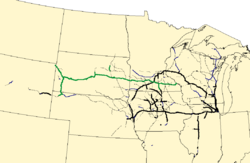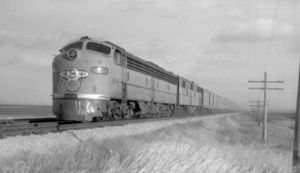Chicago and North Western Railway
2007 Schools Wikipedia Selection. Related subjects: Railway transport
| Chicago and North Western Railway | |
|---|---|
 |
|
 Map of the Chicago and North Western Railway. Black lines are trackage now owned by Union Pacific; green lines are trackage now owned by Dakota, Minnesota and Eastern Railroad; blue lines are now owned by other railroads; dotted lines are abandoned. |
|
| Reporting marks | CNW, CNWS, CNWZ |
| Locale | Illinois, Iowa, Kansas, Michigan, Minnesota, Missouri, Nebraska, North Dakota, South Dakota, Wisconsin, and Wyoming |
| Dates of operation | 1865 – 1995 |
| Successor line | Union Pacific |
| Track gauge | 4 ft 8½ in (1435 mm) ( standard gauge) |
| Headquarters | Chicago, Illinois |
The Chicago and North Western Railway ( AAR reporting marks: CNW, CNWS, CNWZ; unofficial abbreviation: C&NW) was a Class I railroad in the United States. It was also known as the North Western.
History
The Chicago and North Western Railway was chartered on June 7, 1859. It had purchased the assets of the bankrupt Chicago, St. Paul and Fond du Lac Railroad five days earlier. On February 15, 1865, it officially merged with the Galena and Chicago Union Railroad, which had been chartered on January 16, 1836. Since the Galena & Chicago Union started operating in December, 1848, and the Fond du Lac railroad started in March, 1855, the Galena and Chicago Union Railroad is considered to be the origin of the North Western railroad system.
The North Western had owned a majority of the stock of the Chicago, St. Paul, Minneapolis and Omaha Railway (Omaha Road) since 1882. On January 1, 1957, it officially leased the company, and merged it into the North Western in 1972. The Omaha Road's main line ran from an interchange with the North Western at Elroy, Wisconsin, to the Twin Cities, down to Sioux City, Iowa, and then finally to Omaha, Nebraska. The North Western picked up several important short railroads during its later years. It finalized acquisition of the Litchfield and Madison railroad on January 1, 1958. The Litchfield and Madison railroad was a 44-mile bridge road from East St. Louis to Litchfield, Illinois. On July 30, 1968, the North Western acquired two former interurbans – the 36-mile Des Moines and Central Iowa Railway (DM&CI), and the 110-mile Fort Dodge, Des Moines and Southern Railway (FDDM&S). The DM&CI gave access to the Firestone plant in Des Moines, Iowa, and the FDDM&S provided access to gypsum mills in Fort Dodge, Iowa.
On November 1, 1960, the North Western acquired the rail properties of the 1,500-mile Minneapolis and St. Louis Railway. In spite of its name, it ran only from Minneapolis, Minnesota, to Peoria, Illinois. This acquisition provided traffic and modern rolling stock, and eliminated competition.
On July 1, 1968, the 1,500 mile (2,400 km) Chicago Great Western Railway was merged into the North Western. This railroad went from Chicago to Oelwein, Iowa. From there, separate lines went to the Twin Cities, Omaha, Nebraska, and Kansas City, Missouri. A connection from Hayfield, Minnesota, to Clarion, Iowa, provided a Twin Cities to Omaha main line. The Chicago Great Western duplicated the North Western's routes from Chicago to the Twin Cities and Omaha, but went the long way. This merger provided access to Kansas City, Missouri, and eliminated competition. After abandoning a plan to merge with the Milwaukee Road in 1970, Benjamin W. Heineman, who had headed the CNW and parent Northwest Industries since 1956, arranged the sale of the railroad to its employees in 1972. The words " Employee Owned" were part of the company logo in the ensuing period.
After the Chicago, Rock Island & Pacific Railroad (Rock Island) stopped operating on March 31, 1980, the North Western won a bidding war with the Soo Line for purchase of the roughly 800-mile "Spine Line" from the Twin Cities to Kansas City, Missouri, via Des Moines, Iowa. The North Western's bid of $93 million was approved on June 20, 1983, by the ICC. The line was well-engineered, but because of deferred maintenance on the part of the bankrupt Rock Island, a major rehabilitation was undertaken in 1984. The North Western then began to abandon the Oelwein to Kansas City section of its former Chicago Great Western trackage, which duplicated Spine Line service.
In April, 1995, the Chicago and North Western Transportation Company was merged into the Union Pacific Railroad.
Chicago and North Western locomotives continued to operate in their paint schemes for several years after the merger. As of June 22, 2006, only two engines were left in full C&NW paint (C&NW 8646 and 8701), but many others were wearing "patch" Union Pacific numbers over their C&NW scheme.
Union Pacific continues to follow its new tradition of releasing "Heritage" units to represent the paint schemes of companies absorbed by UP. After completion of painting at the Wisconsin & Southern Railroad's Horicon, Wisconsin shop, Union Pacific 1995, an EMD SD70ACe locomotive painted in a "Heritage" Chicago & North Western paint scheme, was unveiled on July 15, 2006, at Ogilvie Transportation Centre in Chicago, IL. OTC is the former North Western Station now serving as UP's Metra terminus. The unit was then placed in dedicated service on the former C&NW main line, paired with the C&NW 8646 and 8701.
Passenger train service
Chicago and Northwestern operated some notable passenger trains, including the City of Los Angeles, City of Denver, and the Challenger. All three lines were jointly operated by CNW and the Union Pacific Railroad from 1936 until 1955, when poor track conditions on the CNW forced UP to switch to the Milwaukee Road for service to Chicago.
The CNW's most famous train, the Chicago-Twin Cities 400 was introduced in 1935 to compete with the Chicago, Burlington and Quincy's Zephyrs and the Milwaukee Road's Hiawathas. This train was named because it traveled the 400 miles between the cities in 400 minutes. CNW was the first system to start a high-speed Chicago-Twin Cities schedule because it used refurbished instead of new equipment, but in 1939, modernized the 400 with new E3A diesel locomotive pairs and streamlined cars.
CNW eventually renamed the first 400 to the Twin Cities 400 as the CNW stuck almost all of its passenger trains with the 400 moniker, including the Flambeau 400, Rochester 400, and the Kate Shelley 400. CNW ceased running the Twin Cities 400 in 1963, and all intercity passenger service on CNW ended with the formation of Amtrak in 1971.

